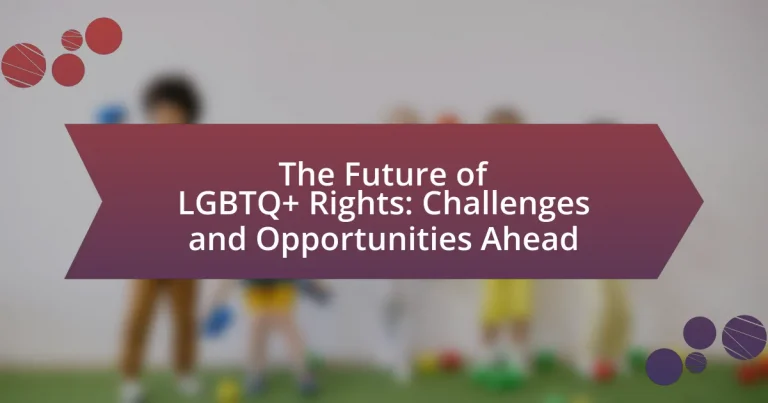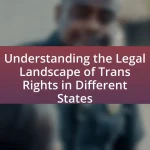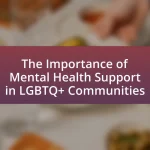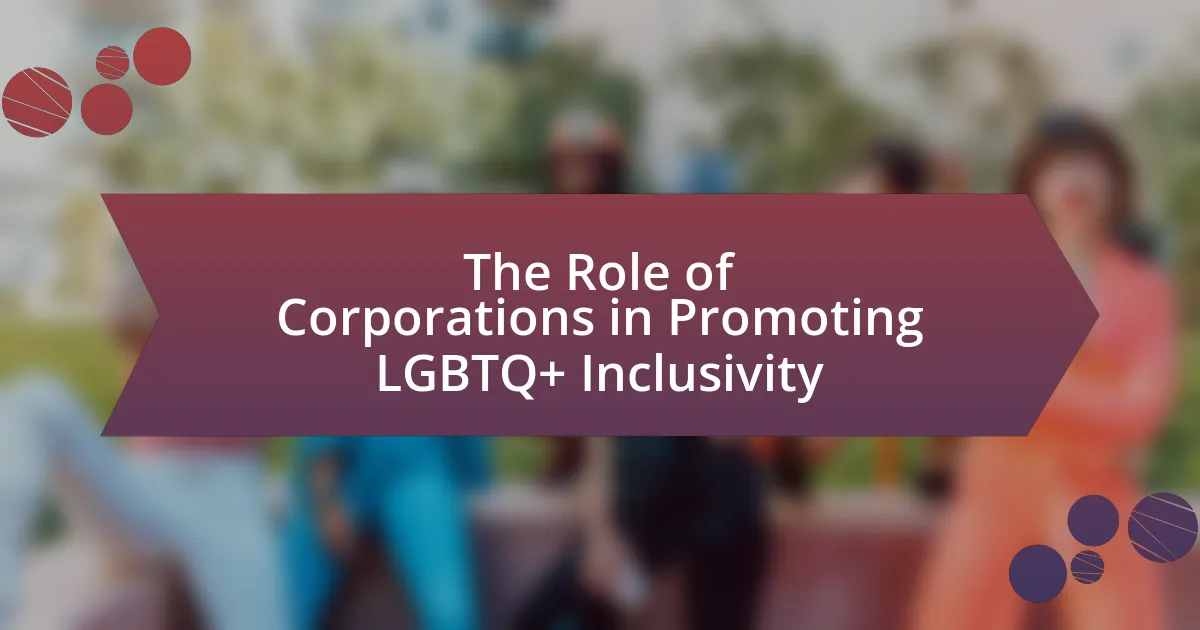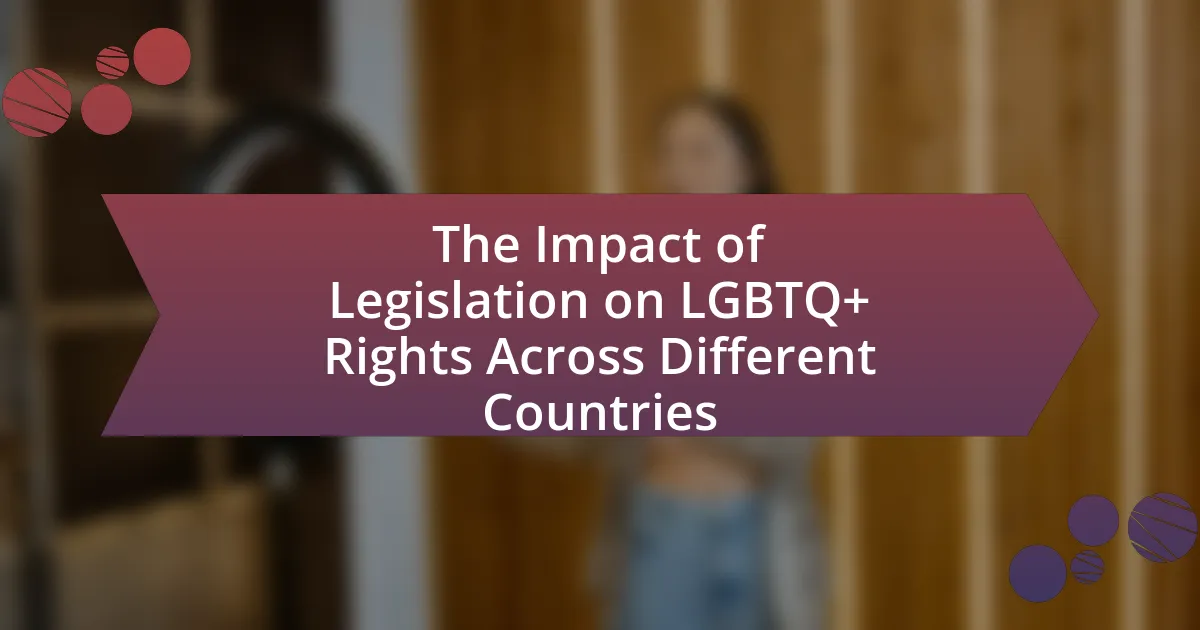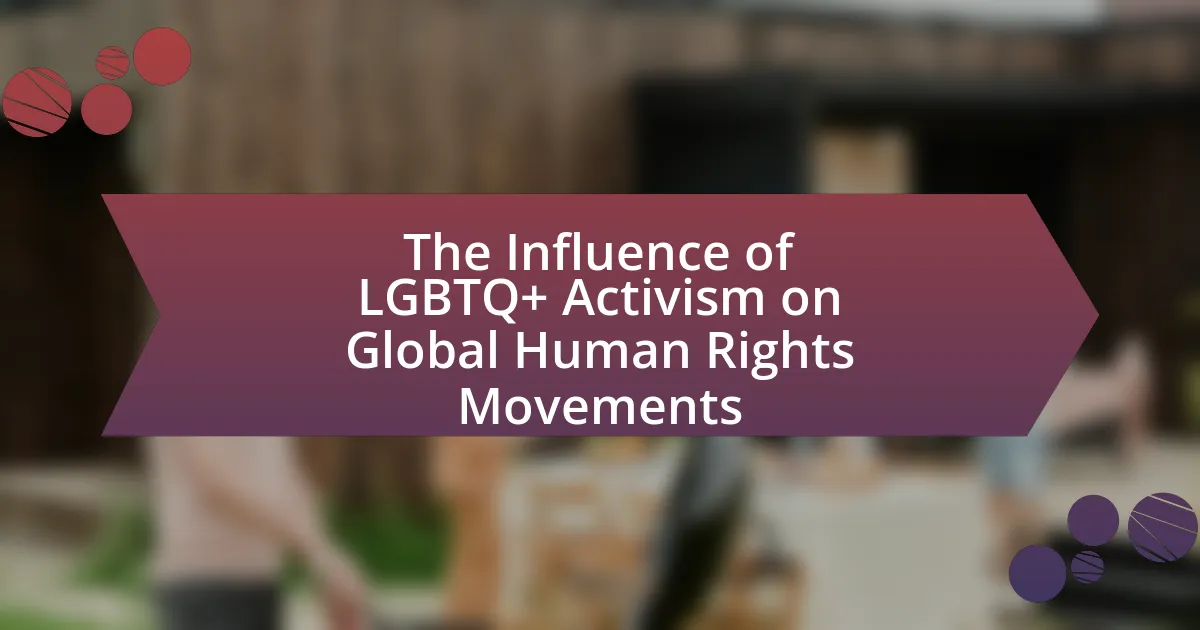The article focuses on the current state and future of LGBTQ+ rights, highlighting significant trends such as increased legal recognition, anti-discrimination protections, and growing societal acceptance. It examines recent legal changes that have advanced LGBTQ+ rights, including landmark rulings and specific laws enacted to protect individuals from discrimination. The article also discusses the varying legal landscapes across different countries, the impact of social movements, and the role of grassroots organizations and public figures in advocacy. Additionally, it addresses ongoing challenges faced by LGBTQ+ individuals, including discrimination and mental health implications, while identifying opportunities for further advancement through education, technology, and community initiatives.

What are the current trends in LGBTQ+ rights?
Current trends in LGBTQ+ rights include increased legal recognition, anti-discrimination protections, and growing acceptance in various societies. Many countries are advancing marriage equality, with over 30 nations legalizing same-sex marriage as of 2023. Additionally, there is a notable rise in anti-discrimination laws aimed at protecting LGBTQ+ individuals in employment, housing, and public services, reflecting a broader societal shift towards inclusivity. Furthermore, public opinion polls indicate that acceptance of LGBTQ+ rights has significantly increased, with a majority of people in many regions supporting equal rights for LGBTQ+ individuals. These trends highlight a progressive movement towards equality, although challenges remain, particularly in regions where LGBTQ+ rights are still under threat.
How have recent legal changes impacted LGBTQ+ rights?
Recent legal changes have significantly advanced LGBTQ+ rights by expanding protections against discrimination and recognizing same-sex marriage in more jurisdictions. For instance, the U.S. Supreme Court’s 2020 ruling in Bostock v. Clayton County established that employment discrimination based on sexual orientation or gender identity is prohibited under Title VII of the Civil Rights Act of 1964. This landmark decision reinforced the legal framework supporting LGBTQ+ individuals and has led to increased workplace protections across the country. Additionally, various states have enacted laws that safeguard LGBTQ+ rights in areas such as healthcare access and housing, further promoting equality and inclusion.
What specific laws have been enacted to protect LGBTQ+ individuals?
Numerous specific laws have been enacted to protect LGBTQ+ individuals, including the Employment Non-Discrimination Act (ENDA), which prohibits employment discrimination based on sexual orientation and gender identity. Additionally, the Matthew Shepard and James Byrd, Jr. Hate Crimes Prevention Act expands federal hate crime laws to include those motivated by sexual orientation and gender identity. The legalization of same-sex marriage through the Supreme Court ruling in Obergefell v. Hodges in 2015 further solidified legal protections for LGBTQ+ individuals. These laws collectively aim to ensure equal rights and protections under the law for LGBTQ+ individuals in various aspects of life, including employment, housing, and personal relationships.
How do these laws vary across different countries?
Laws regarding LGBTQ+ rights vary significantly across different countries, reflecting diverse cultural, social, and political contexts. For instance, countries like Canada and the Netherlands have legalized same-sex marriage and implemented comprehensive anti-discrimination laws, while nations such as Saudi Arabia and Uganda impose severe penalties, including imprisonment or death, for homosexual acts. According to the International Lesbian, Gay, Bisexual, Trans and Intersex Association (ILGA), as of 2021, 29 countries have legalized same-sex marriage, whereas over 70 countries still criminalize same-sex relationships. This stark contrast illustrates the global disparity in legal protections and rights for LGBTQ+ individuals.
What social movements are shaping the future of LGBTQ+ rights?
The social movements shaping the future of LGBTQ+ rights include the global marriage equality movement, the transgender rights movement, and intersectional advocacy efforts. The global marriage equality movement has led to significant legal changes, with over 30 countries recognizing same-sex marriage as of 2023, reflecting a shift towards greater acceptance and legal protection for LGBTQ+ individuals. The transgender rights movement has gained momentum, advocating for policies that protect transgender individuals from discrimination and violence, highlighted by the introduction of gender-affirming healthcare in various regions. Intersectional advocacy efforts focus on the unique challenges faced by LGBTQ+ individuals of color, emphasizing the need for inclusive policies that address systemic inequalities. These movements collectively influence public opinion and legislative changes, driving progress in LGBTQ+ rights.
How are grassroots organizations influencing policy changes?
Grassroots organizations are influencing policy changes by mobilizing community members to advocate for LGBTQ+ rights and engage in direct action. These organizations often utilize social media campaigns, public demonstrations, and grassroots lobbying to raise awareness and pressure policymakers. For instance, the Human Rights Campaign reported that grassroots efforts played a crucial role in the passage of marriage equality laws in various states, showcasing how local activism can lead to significant legislative changes. Additionally, studies indicate that grassroots movements can shift public opinion, which in turn influences policymakers to adopt more inclusive policies.
What role do celebrities and public figures play in advocacy?
Celebrities and public figures play a crucial role in advocacy by leveraging their visibility and influence to raise awareness and support for various causes, including LGBTQ+ rights. Their platforms allow them to reach large audiences, effectively mobilizing public opinion and encouraging social change. For instance, high-profile figures like Ellen DeGeneres and Laverne Cox have used their fame to advocate for LGBTQ+ equality, contributing to increased visibility and acceptance of LGBTQ+ issues in mainstream culture. Research indicates that celebrity endorsements can significantly impact public attitudes; a study published in the Journal of Social Issues found that celebrities who openly support LGBTQ+ rights can lead to greater acceptance among their fans.
What challenges do LGBTQ+ individuals still face today?
LGBTQ+ individuals still face significant challenges today, including discrimination, violence, and lack of legal protections. According to the Human Rights Campaign, 2021 saw a record number of reported violent incidents against transgender individuals, particularly transgender women of color, highlighting ongoing violence. Additionally, many states in the U.S. have enacted or proposed legislation that targets LGBTQ+ rights, such as restrictions on gender-affirming care for minors and limitations on discussions of sexual orientation and gender identity in schools. Furthermore, a 2020 survey by the Williams Institute found that nearly 30% of LGBTQ+ individuals reported experiencing discrimination in employment, housing, or public accommodations. These statistics underscore the persistent inequalities and societal challenges that LGBTQ+ individuals continue to navigate.
How does discrimination manifest in various sectors?
Discrimination manifests in various sectors through unequal treatment, exclusion, and bias against individuals based on their sexual orientation or gender identity. In the workplace, LGBTQ+ individuals often face hiring biases, wage disparities, and hostile work environments; for example, a 2021 report by the Human Rights Campaign found that 46% of LGBTQ+ workers experienced discrimination in the hiring process. In healthcare, discrimination can lead to inadequate care, as LGBTQ+ patients may encounter providers who lack cultural competency or exhibit bias, resulting in poorer health outcomes. In education, LGBTQ+ students frequently experience bullying and harassment, which can hinder their academic performance and mental health; the 2019 National School Climate Survey indicated that 60% of LGBTQ+ students felt unsafe at school due to their sexual orientation. These manifestations of discrimination highlight systemic issues that persist across multiple sectors, impacting the rights and well-being of LGBTQ+ individuals.
What are the mental health implications of ongoing stigma?
Ongoing stigma has significant negative mental health implications, including increased rates of anxiety, depression, and suicidal ideation among marginalized groups. Research indicates that individuals facing stigma often experience social isolation and reduced access to mental health resources, which exacerbates their psychological distress. For instance, a study published in the American Journal of Public Health found that LGBTQ+ individuals who encounter stigma are more likely to report mental health issues, with 39% of LGBTQ+ youth experiencing serious psychological distress compared to 14% of their heterosexual peers. This evidence underscores the detrimental effects of stigma on mental well-being, highlighting the urgent need for societal change to improve mental health outcomes for affected populations.

What opportunities exist for advancing LGBTQ+ rights?
Opportunities for advancing LGBTQ+ rights include legislative reforms, increased visibility in media, and global advocacy efforts. Legislative reforms, such as the Equality Act in the United States, aim to prohibit discrimination based on sexual orientation and gender identity, thereby enhancing legal protections for LGBTQ+ individuals. Increased visibility in media, including representation in films and television, fosters acceptance and understanding, which can lead to societal change. Global advocacy efforts, such as campaigns by organizations like Human Rights Campaign and ILGA World, work to address human rights violations against LGBTQ+ individuals worldwide, promoting equality and justice. These opportunities collectively contribute to a more inclusive society and the advancement of LGBTQ+ rights.
How can technology aid in the fight for LGBTQ+ rights?
Technology can aid in the fight for LGBTQ+ rights by providing platforms for advocacy, community building, and information dissemination. Social media enables LGBTQ+ activists to reach a global audience, mobilizing support for campaigns and raising awareness about issues such as discrimination and violence. For instance, hashtags like #LoveIsLove have sparked widespread conversations and visibility for LGBTQ+ rights, leading to significant social change. Additionally, online resources and apps offer legal assistance and mental health support tailored to LGBTQ+ individuals, enhancing access to necessary services. Data from the Human Rights Campaign indicates that technology-driven initiatives have played a crucial role in advancing LGBTQ+ rights, particularly in regions where traditional advocacy methods face significant barriers.
What platforms are being used for advocacy and awareness?
Social media platforms such as Twitter, Facebook, Instagram, and TikTok are being used for advocacy and awareness in the LGBTQ+ rights movement. These platforms enable organizations and individuals to share information, mobilize support, and engage in discussions about LGBTQ+ issues. For instance, campaigns like #LoveIsLove on Twitter and Instagram have successfully raised awareness and fostered community support, demonstrating the effectiveness of these platforms in promoting advocacy. Additionally, platforms like Change.org facilitate petitions that can lead to significant policy changes, further illustrating their role in advocacy efforts.
How does social media influence public perception of LGBTQ+ issues?
Social media significantly influences public perception of LGBTQ+ issues by shaping narratives, increasing visibility, and fostering community engagement. Platforms like Twitter, Instagram, and Facebook allow LGBTQ+ individuals and allies to share personal stories, advocate for rights, and mobilize support, which can lead to greater acceptance and understanding. For instance, a 2020 study published in the Journal of Social Issues found that exposure to LGBTQ+ content on social media positively correlated with increased support for LGBTQ+ rights among users. This demonstrates that social media acts as a powerful tool for education and advocacy, ultimately impacting societal attitudes toward LGBTQ+ communities.
What role does education play in promoting LGBTQ+ rights?
Education plays a crucial role in promoting LGBTQ+ rights by fostering understanding, acceptance, and advocacy among individuals and communities. Through comprehensive curricula that include LGBTQ+ history, issues, and contributions, educational institutions can challenge stereotypes and reduce discrimination. Research indicates that inclusive education leads to safer environments for LGBTQ+ students, as evidenced by a 2019 study from the Gay, Lesbian & Straight Education Network (GLSEN), which found that schools with LGBTQ+ inclusive curricula reported lower levels of bullying and harassment. This educational approach not only empowers LGBTQ+ individuals but also cultivates allies, thereby advancing societal acceptance and legal protections for LGBTQ+ rights.
How can schools create inclusive environments for LGBTQ+ students?
Schools can create inclusive environments for LGBTQ+ students by implementing comprehensive anti-bullying policies and promoting LGBTQ+ awareness through education. Research indicates that schools with clear anti-bullying policies that specifically mention sexual orientation and gender identity see a reduction in harassment and discrimination, fostering a safer atmosphere for all students. Additionally, integrating LGBTQ+ topics into the curriculum helps normalize diverse identities and experiences, which has been shown to improve the mental health and academic performance of LGBTQ+ students. For instance, a study by GLSEN found that LGBTQ+ students who attended schools with inclusive curricula reported feeling safer and more supported.
What educational programs are effective in raising awareness?
Educational programs that are effective in raising awareness about LGBTQ+ rights include comprehensive school curricula, community workshops, and online training modules. Comprehensive school curricula, such as those implemented in various states, integrate LGBTQ+ history and issues into subjects like social studies and health education, fostering understanding from an early age. Community workshops, often led by local LGBTQ+ organizations, provide interactive sessions that engage participants in discussions about rights, challenges, and allyship. Online training modules, such as those offered by organizations like the Human Rights Campaign, allow individuals to learn at their own pace about LGBTQ+ issues, promoting inclusivity and awareness. These programs have been shown to reduce stigma and increase acceptance, as evidenced by studies indicating that schools with inclusive curricula report lower rates of bullying and higher levels of support for LGBTQ+ students.
What partnerships can enhance the fight for LGBTQ+ rights?
Strategic partnerships between LGBTQ+ organizations and various sectors can significantly enhance the fight for LGBTQ+ rights. Collaborations with human rights organizations, educational institutions, and corporate allies can amplify advocacy efforts, increase visibility, and provide essential resources. For instance, partnerships with human rights organizations like Amnesty International have historically led to global campaigns that raise awareness and influence policy changes, as seen in the 2019 “Love is a Human Right” campaign. Additionally, corporate partnerships, such as those with companies that support LGBTQ+ inclusion, can provide funding and platforms for advocacy, evidenced by the Human Rights Campaign’s Corporate Equality Index, which highlights businesses committed to LGBTQ+ equality. These collaborations create a multifaceted approach to advancing rights and protections for LGBTQ+ individuals.
How can collaborations between organizations strengthen advocacy efforts?
Collaborations between organizations can strengthen advocacy efforts by pooling resources, expertise, and networks to create a more unified and powerful voice for change. When organizations work together, they can amplify their messages, reach broader audiences, and increase their impact on policy and public opinion. For example, joint campaigns can leverage the strengths of each organization, such as one group’s legal expertise and another’s grassroots mobilization capabilities, leading to more effective advocacy strategies. Research shows that coalitions can lead to a 30% increase in successful policy outcomes compared to isolated efforts, demonstrating the tangible benefits of collaboration in advocacy.
What role do international alliances play in supporting LGBTQ+ rights?
International alliances play a crucial role in supporting LGBTQ+ rights by providing a platform for advocacy, sharing best practices, and exerting diplomatic pressure on nations with discriminatory laws. These alliances, such as the United Nations Free & Equal campaign and the International Lesbian, Gay, Bisexual, Trans and Intersex Association (ILGA), work to promote equality and protect LGBTQ+ individuals globally. For instance, the UN has established various resolutions affirming the rights of LGBTQ+ people, which encourages member states to adopt more inclusive policies. Additionally, international coalitions can mobilize resources and support for grassroots organizations, enhancing their capacity to fight for rights in their respective countries. This collaborative approach has been instrumental in advancing legal reforms and increasing visibility for LGBTQ+ issues worldwide.

What can individuals do to support LGBTQ+ rights?
Individuals can support LGBTQ+ rights by actively advocating for equality and inclusion through various means. This includes participating in local and national advocacy groups that focus on LGBTQ+ issues, which can amplify voices and influence policy changes. Additionally, individuals can educate themselves and others about LGBTQ+ history and rights, fostering a more informed community that understands the challenges faced by LGBTQ+ individuals. Supporting LGBTQ+ businesses and artists also contributes to economic empowerment within the community. Furthermore, individuals can engage in allyship by standing against discrimination and promoting inclusive practices in workplaces and social settings. Research indicates that public support for LGBTQ+ rights has increased, with a 2021 Gallup poll showing that 70% of Americans support same-sex marriage, highlighting the impact of individual advocacy on societal attitudes.
How can allies effectively advocate for LGBTQ+ rights?
Allies can effectively advocate for LGBTQ+ rights by actively supporting policies that promote equality and inclusion. This includes lobbying for anti-discrimination laws, participating in pride events, and using their platforms to amplify LGBTQ+ voices. Research indicates that public support for LGBTQ+ rights has increased, with a 2021 Gallup poll showing that 70% of Americans support same-sex marriage, highlighting the growing acceptance and the importance of allyship in fostering a more inclusive society.
What actions can individuals take to raise awareness?
Individuals can raise awareness about LGBTQ+ rights by engaging in community education initiatives. These initiatives can include organizing workshops, discussions, and informational sessions that highlight LGBTQ+ issues and promote understanding. Research indicates that educational programs significantly increase awareness and empathy towards marginalized communities, as seen in studies conducted by the Human Rights Campaign, which found that informed individuals are more likely to support LGBTQ+ rights. Additionally, individuals can utilize social media platforms to share informative content, personal stories, and resources, amplifying LGBTQ+ voices and experiences to a broader audience.
How can one support local LGBTQ+ organizations?
One can support local LGBTQ+ organizations by donating funds, volunteering time, and participating in events. Financial contributions provide essential resources for programs and services that promote LGBTQ+ rights and well-being. Volunteering allows individuals to offer skills and support directly to the organization, enhancing its capacity to serve the community. Additionally, attending events raises awareness and fosters community engagement, which is crucial for the sustainability of these organizations. According to a report by the Human Rights Campaign, local LGBTQ+ organizations often rely on community support to continue their advocacy and outreach efforts, highlighting the importance of active participation in these initiatives.
What are the best practices for creating inclusive spaces?
The best practices for creating inclusive spaces involve actively promoting diversity, ensuring accessibility, and fostering a culture of respect and belonging. Organizations should implement policies that explicitly prohibit discrimination based on sexual orientation and gender identity, as evidenced by the Human Rights Campaign’s findings that inclusive policies lead to higher employee satisfaction and retention rates. Additionally, physical spaces should be designed to accommodate individuals of all abilities, which can be supported by the Americans with Disabilities Act guidelines. Training programs that educate staff on LGBTQ+ issues and encourage allyship are also essential, as studies show that awareness and understanding significantly improve the experiences of marginalized groups in various environments.
How can workplaces implement policies that support LGBTQ+ employees?
Workplaces can implement policies that support LGBTQ+ employees by establishing non-discrimination policies that explicitly include sexual orientation and gender identity. These policies create a legal framework that protects LGBTQ+ individuals from discrimination in hiring, promotions, and workplace treatment. According to a 2021 report by the Human Rights Campaign, 90% of LGBTQ+ workers reported experiencing workplace discrimination, highlighting the need for such policies. Additionally, providing diversity training and creating employee resource groups can foster an inclusive environment, as studies show that inclusive workplaces lead to higher employee satisfaction and retention rates.
What community initiatives can foster inclusivity?
Community initiatives that can foster inclusivity include LGBTQ+ awareness programs, support groups, and inclusive policy advocacy. These initiatives create safe spaces for dialogue, promote understanding, and encourage acceptance within diverse communities. For instance, research from the Human Rights Campaign indicates that inclusive workplace policies significantly improve employee morale and productivity, demonstrating the positive impact of such initiatives on community dynamics. Additionally, community events like pride parades and educational workshops help raise awareness and visibility, further promoting inclusivity and acceptance.
What resources are available for those wanting to learn more?
Resources available for those wanting to learn more about LGBTQ+ rights include academic journals, online courses, and advocacy organization websites. Academic journals such as the “Journal of Homosexuality” provide peer-reviewed articles on LGBTQ+ issues, while platforms like Coursera and edX offer courses on gender studies and human rights. Additionally, organizations like the Human Rights Campaign and GLAAD provide extensive resources, including reports, educational materials, and community support initiatives, which help individuals understand the current challenges and opportunities in LGBTQ+ rights.
Where can individuals find educational materials on LGBTQ+ rights?
Individuals can find educational materials on LGBTQ+ rights through various reputable organizations and online platforms. Notable sources include the Human Rights Campaign, which provides comprehensive resources on LGBTQ+ issues, and the American Civil Liberties Union, which offers legal information and advocacy materials. Additionally, websites like GLAAD and the Trevor Project focus on LGBTQ+ awareness and education, providing guides, articles, and research. These organizations are recognized for their commitment to promoting LGBTQ+ rights and have extensive archives of educational content that can be accessed freely by the public.
What online communities offer support and information?
Online communities that offer support and information for LGBTQ+ individuals include Reddit’s LGBTQ+ subreddit, LGBTQ+ specific Facebook groups, and forums like Empty Closets. These platforms provide a space for sharing experiences, seeking advice, and accessing resources related to LGBTQ+ rights and issues. For instance, the LGBTQ+ subreddit has over 300,000 members who engage in discussions about personal challenges and advocacy, demonstrating the community’s active support network.
